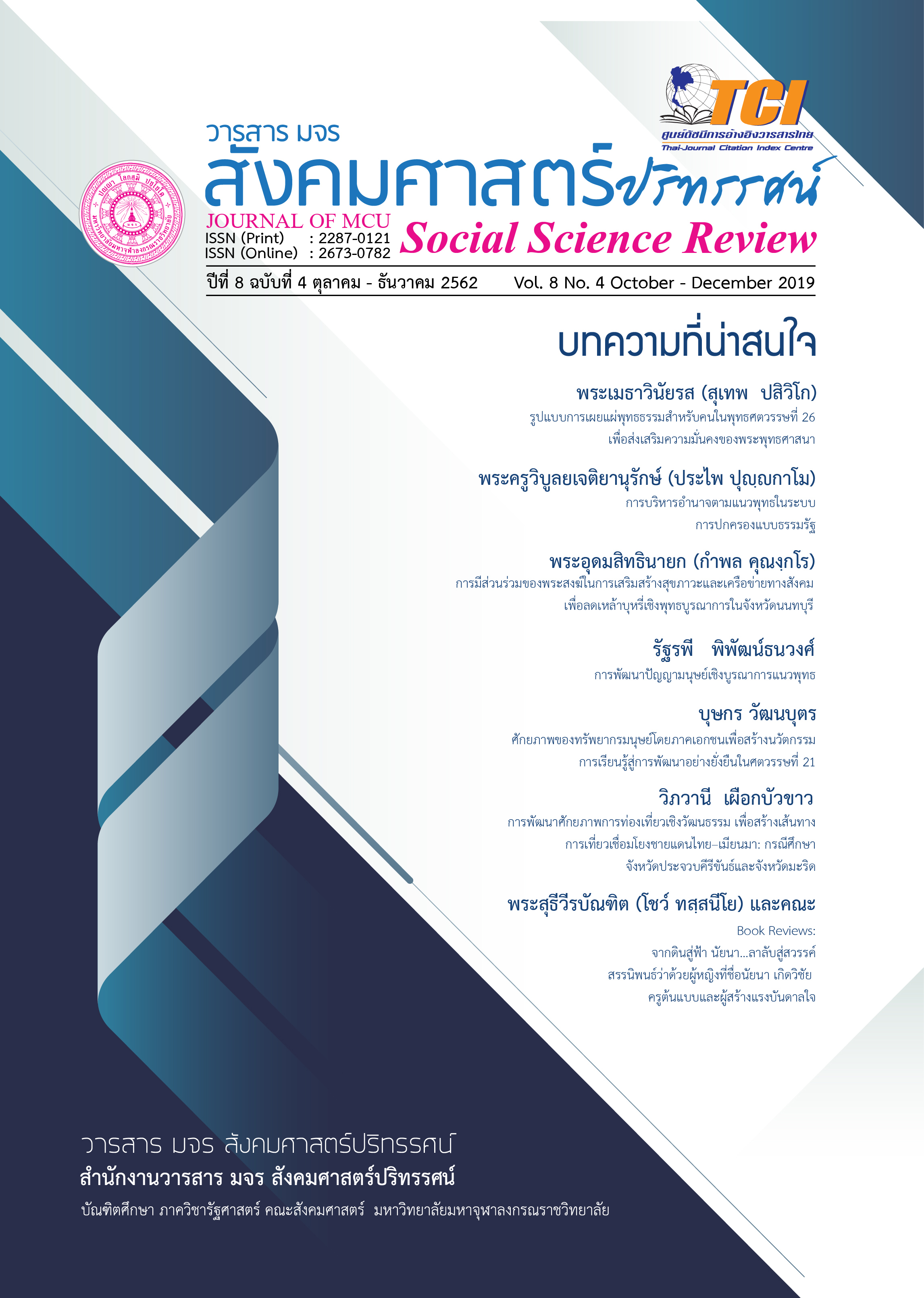การพัฒนาศักยภาพพระสอนศีลธรรมในโรงเรียนมัธยมศึกษา ตอนปลายในเขตปกครองคณะสงฆ์ภาค 15
คำสำคัญ:
การพัฒนาศักยภาพ, พระสอนศีลธรรมในโรงเรียนบทคัดย่อ
บทความวิจัยฉบับนี้มีวัตถุประสงค์1.เพื่อศึกษาสภาพทั่วไปเกี่ยวกับพระสอนศีลธรรมในโรงเรียนมัธยมศึกษาตอนปลาย ในเขตปกครองคณะสงฆ์ภาค 152.เพื่อศึกษาปัจจัยที่มีความสัมพันธ์กับศักยภาพพระสอนศีลธรรมในโรงเรียนมัธยมศึกษาตอนปลาย ในเขตปกครองคณะสงฆ์ภาค 15และ3.เพื่อนำเสนอการพัฒนาศักยภาพพระสอนศีลธรรมในโรงเรียนมัธยมศึกษาตอนปลาย ในเขตปกครองคณะสงฆ์ภาค 15การวิจัยเป็นแบบผสานวิธี โดยใช้ระเบียบการวิจัยเชิงคุณภาพ ด้วยการวิเคราะห์เอกสาร การสัมภาษณ์เชิงลึกจากผู้ให้ข้อมูลสำคัญ ที่เป็นผู้บริหารโครงการพระสอนศีลธรรม และผู้บริหารสถานศึกษาจำนวน 18 รูปหรือคน และการสนทนากลุ่มเฉพาะกับผู้เชี่ยวชาญจำนวน12รูปหรือคนการวิเคราะห์ข้อมูลโดยใช้วิธีการวิเคราะห์เนื้อหาเชิงพรรณนาเรียบเรียงและจำแนกอย่างเป็นระบบ และใช้ระเบียบวิธีวิจัยเชิงปริมาณ ด้วยการแจกแบบสอบถาม ซึ่งมีค่าความเชื่อมั่นทั้งฉบับเท่ากับ 0.988 กับพระสอนศีลธรรมในเขตปกครองคณะสงฆ์ภาค 15จำนวน 253 รูป สถิติที่ใช้ในการวิจัยคือ ค่าความถี่ ค่าร้อยละ ค่าเฉลี่ย ค่าเบี่ยงเบนมาตรฐานค่าสัมประสิทธิ์สหสัมพันธ์เพียร์สัน ผลการวิจัยพบว่า 1. สภาพทั่วไปในการพัฒนาศักยภาพพระสอนศีลธรรมในโรงเรียนมัธยมศึกษาตอนปลาย ในเขตปกครองคณะสงฆ์ภาค 15 พบว่ามีการประชุมวางแผนเพื่อกำหนดนโยบาย และทำความเข้าใจเกี่ยวกับการดำเนินงานโรงเรียนมัธยมศึกษาตอนปลาย ในเขตปกครองคณะสงฆ์ภาค 15ที่ชัดเจน มีการนำนโยบายที่ได้มาสู่การปฏิบัติ ส่งเสริมให้ผู้เรียนเกิดการพัฒนาอย่างต่อเนื่องและเป็นประจำ มีการสนับสนุนให้พระสอนศีลธรรมมีความรับผิดชอบในการถ่ายทอดหลักพุทธธรรม ส่งเสริมงบประมาณในการจัดกิจกรรมมีการประเมินผลทั้งการเรียนการสอนและกิจกรรมวิถีพุทธทั้งครูและนักเรียน มีการสนับสนุนงบประมาณเพื่อปรับปรุงกิจกรรมโรงเรียนมัธยมศึกษาตอนปลาย ในเขตปกครองคณะสงฆ์ภาค 15 ให้มีประสิทธิภาพและเอื้อต่อการเรียนรู้ของนักเรียน 2. ปัจจัยที่มีความสัมพันธ์กับการพัฒนาศักยภาพพระสอนศีลธรรมในโรงเรียนมัธยมศึกษาตอนปลาย ในเขตปกครองคณะสงฆ์ภาค 15 นั้น พบว่า ปัจจัยด้านประเภทของศักยภาพในการทำงานกับการพัฒนาศักยภาพพระสอนศีลธรรมในโรงเรียนมีความสัมพันธ์กัน และมีความสัมพันธ์กันในระดับมาก (r = 0.940, p-value= 0.000) และ ปัจจัยด้านภาวนา 4กับการพัฒนาศักยภาพพระสอนศีลธรรมในโรงเรียนมีความสัมพันธ์กัน และมีความสัมพันธ์กันในระดับมาก (r = 0.941, p-value= 0.000) 3. การพัฒนาศักยภาพพระสอนศีลธรรมในโรงเรียนมัธยมศึกษาตอนปลาย ในเขตปกครองคณะสงฆ์ภาค 15 มี 5ขั้น คือ 1) การพัฒนาศักยภาพพระสอนศีลธรรม ในโรงเรียนมัธยมศึกษาตอนปลาย ในเขตปกครองคณะสงฆ์ภาค 15 ด้านเนื้อหาการสอนได้แก่ การจัดทำปฏิทินปฏิบัติงาน ในรอบปีการศึกษา การพัฒนาผู้สอนให้ใช้วิธีการที่เหมาะสมกับผู้เรียน จะทำให้การเรียนของผู้เรียน เป็นไปอย่างมีประสิทธิภาพและเกิดประสิทธิผล2) การพัฒนาศักยภาพพระสอนศีลธรรม ในโรงเรียนมัธยมศึกษาตอนปลาย ในเขตปกครองคณะสงฆ์ภาค 15 ด้านวิธีการสอนได้แก่ การกำหนดห้องเรียน ชั้นเรียน ห้องสมุด ห้องประชุม ห้องน้ำ หนังสือเรียน ตำราเรียน สมุด ดินสอ ปากกา กระดาษ กระดานเขียน โต๊ะ ตู้ เก้าอี้ โปรเจคเตอร์ช่วยสอน คอมพิวเตอร์ สื่อการสอน ไฟฟ้า นำประปา เป็นต้น 3) การพัฒนาศักยภาพพระสอนศีลธรรม ในโรงเรียนมัธยมศึกษาตอนปลาย ในเขตปกครองคณะสงฆ์ภาค 15 ด้านการใช้สื่อการสอน ได้แก่ การนำหลักธรรมเข้ามาประยุกต์กับการสอน จัดการเรียนรู้โดยมี สื่อ วีซีดี คอมพิวเตอร์ช่วยในการสอน จัดการเรียนรู้โดยนำเหตุการณ์ที่เกิดขึ้นในปัจจุบันประยุกต์ใช้ในการสอน4)การพัฒนาศักยภาพพระสอนศีลธรรม ในโรงเรียนมัธยมศึกษาตอนปลาย ในเขตปกครองคณะสงฆ์ภาค 15 ด้านการจัดกิจกรรมการเรียนการสอน ได้แก่ การพัฒนากิจกรรมในการจัดการการเรียนการสอนขั้นปฏิบัติ เป็นกิจกรรมหลักของการเรียนการสอนเพื่อให้ผู้เรียนสามารถเรียนรู้ตามวัตถุประสงค์ที่กำหนดไว้ 5) การพัฒนาศักยภาพพระสอนศีลธรรม ในโรงเรียนมัธยมศึกษาตอนปลาย ในเขตปกครองคณะสงฆ์ภาค 15 ด้านการวัดผลและประเมินผลได้แก่ การเชิญวิทยากรหรือผู้เชี่ยวชาญมาให้คำแนะนำในด้านทักษะเพื่อสร้างความรู้ความเข้าใจให้พระสอนศีลธรรมในด้านการวัดผลและประเมินผลจากแฟ้มงานสะสม
เอกสารอ้างอิง
Boam. R. and Sparrow. P.. (1992). Designing and Achieving Competency. McGraw-Hill.Reading.
Chong Tek Aik. (2007). “The Effects of Visual Training and Visual Aids on the Performance of New Workers on a Wood Products Assembly Line”. Doctoral Dissertation. Walden University.
D. A. Mazmanian. & P. A. Sabatier. (1989). Implementation and Publicpolicy : With a New Postscript Latham. MD: University Press ofAmerica.
Dale. Edgar.(1969). Audio – Visual Materials of Instruction. Chicago : University of Chicago Press.
David Easton. (1953). The Political System An Inquiry in to the State of Political Science. New York : Alfred A. Knorf.
Denise Rucker. (2003). “Leading the Transition from Training to Performance: Improving Human Performance through the Implementation of Training and Non Training Interventions”. Doctoral Dissertation. Walden University.
Gagne. R. M.. (1985). The Conditions of Learning and Theory of Instruction. 4th ed.. New York: Educational Technology Publication.
Gary Lawrence Davis. (2006). “Human Resource Interventions and Training in Downsized Organizations to Assist Remaining Employees”. Doctoral Dissertation. North Carolina State University.
ดาวน์โหลด
เผยแพร่แล้ว
รูปแบบการอ้างอิง
ฉบับ
ประเภทบทความ
สัญญาอนุญาต
ลิขสิทธิ์ (c) 2019 วารสาร มจร สังคมศาสตร์ปริทรรศน์

อนุญาตภายใต้เงื่อนไข Creative Commons Attribution-NonCommercial-NoDerivatives 4.0 International License.
เพื่อให้เป็นไปตามกฎหมายลิขสิทธิ์ ผู้นิพนธ์ทุกท่านต้องลงลายมือชื่อในแบบฟอร์มใบมอบลิขสิทธิ์บทความให้แก่วารสารฯ พร้อมกับบทความต้นฉบับที่ได้แก้ไขครั้งสุดท้าย นอกจากนี้ ผู้นิพนธ์ทุกท่านต้องยืนยันว่าบทความต้นฉบับที่ส่งมาตีพิมพ์นั้น ได้ส่งมาตีพิมพ์เฉพาะในวารสาร มจร สังคมศาสตร์ปริทรรศน์ เพียงแห่งเดียวเท่านั้น หากมีการใช้ภาพหรือตารางหรือเนื้อหาอื่นๆ ของผู้นิพนธ์อื่นที่ปรากฏในสิ่งตีพิมพ์อื่นมาแล้ว ผู้นิพนธ์ต้องขออนุญาตเจ้าของลิขสิทธิ์ก่อน พร้อมทั้งแสดงหนังสือที่ได้รับการยินยอมต่อบรรณาธิการ ก่อนที่บทความจะได้รับการตีพิมพ์ หากไม่เป็นไปตามข้อกำหนดเบื้องต้น ทางวารสารจะถอดบทความของท่านออกโดยไม่มีข้อยกเว้นใดๆ ทั้งสิ้น





